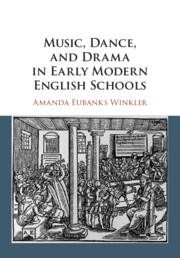Book contents
- Music, Dance, and Drama in Early Modern English Schools
- Music, Dance, and Drama in Early Modern English Schools
- Copyright page
- Dedication
- Contents
- Figures
- Tables
- Music Examples
- Preface
- Editorial Method
- Abbreviations and RISM Sigla
- Introduction
- 1 Situating Pedagogical Performance
- 2 Performing Piety
- 3 Performing Prestige
- 4 Performing Accomplishment
- 5 Performing Vice
- 6 Performing the Professional
- 7 Performing the Past: The Specter of the Schoolroom
- Bibliography
- Index
6 - Performing the Professional
Published online by Cambridge University Press: 14 May 2020
- Music, Dance, and Drama in Early Modern English Schools
- Music, Dance, and Drama in Early Modern English Schools
- Copyright page
- Dedication
- Contents
- Figures
- Tables
- Music Examples
- Preface
- Editorial Method
- Abbreviations and RISM Sigla
- Introduction
- 1 Situating Pedagogical Performance
- 2 Performing Piety
- 3 Performing Prestige
- 4 Performing Accomplishment
- 5 Performing Vice
- 6 Performing the Professional
- 7 Performing the Past: The Specter of the Schoolroom
- Bibliography
- Index
Summary
This chapter teases out the physical realities of the relationship between students and professionals in performance as well as the blurry (but discursively policed) distinction between public and private, between occupational and recreational. In some cases, academies were transformed into concert rooms, as a few entrepreneurial pedagogues held performances that showcased the skills of the masters at their schools. Entertainments at grammar and boarding schools by students also attracted a broad range of interested spectators, well beyond parents and other relatives. Despite the benefits of performance before an audience (bolstering the visibility of the school, displaying the accomplishments of students and teachers), the public-ness of schoolroom concerts, masques, operas, or musical plays made pedagogical spaces disturbingly accessible to outsiders, eroding the perceived exclusiveness of the institutions. Furthermore, performing for a “public” troubled the boundary between student and professional, a liminality particularly acute in situations where professionals actually performed with students. After the Restoration a further problem was posed by the sexually suspect professional actress: prologues and epilogues sought to distance schoolgirl performers from their professional counterparts, even as boarding school entertainments paradoxically deployed some of the same eroticized dramatic and musical conventions as the public stage.
Keywords
- Type
- Chapter
- Information
- Music, Dance, and Drama in Early Modern English Schools , pp. 162 - 194Publisher: Cambridge University PressPrint publication year: 2020

